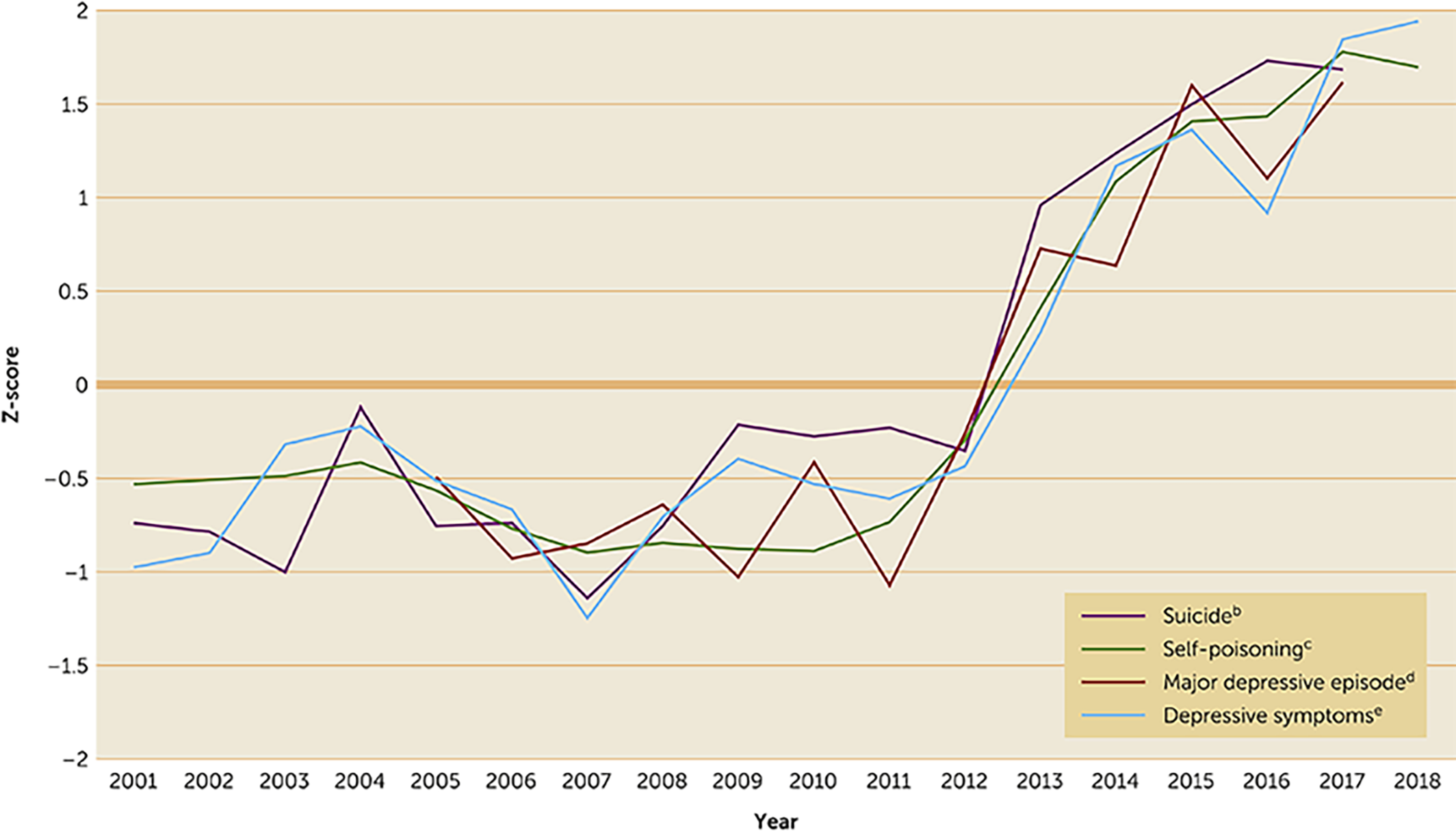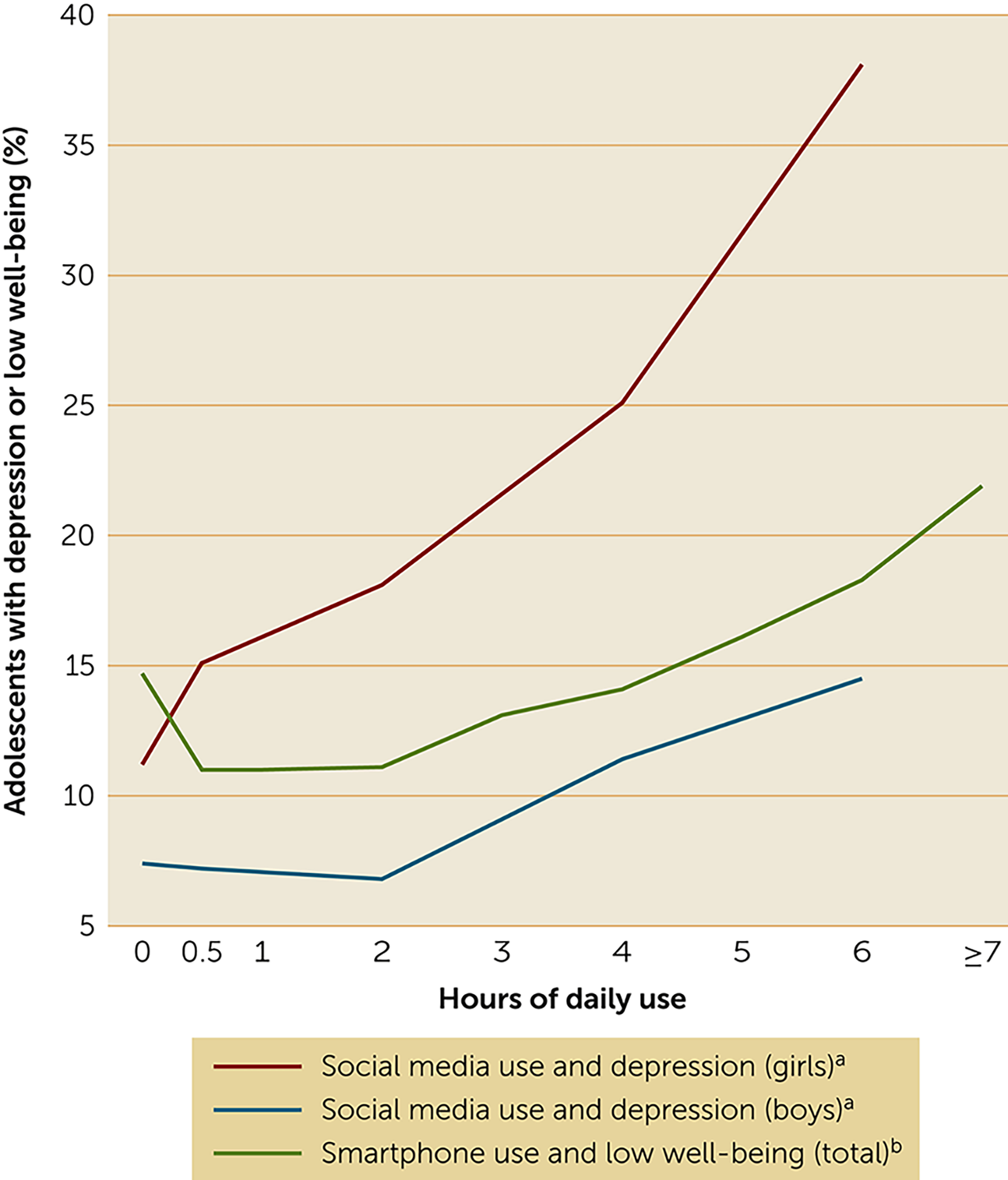If the sharp increase in mental health issues is connected to the rise of digital media and electronic device use, it is important to understand how such use may contribute to mental health. The simplest explanation is that more frequent digital media use leads to mental health issues, so as digital media use rises, mental health issues will also rise. However, this explanation does not determine why more frequent digital media use may cause mental health issues, nor does it explore consequences of digital media use beyond time spent. In addition, it does not recognize that effects operate not just at the individual level but also at the group level, such that the rise in digital media use among adolescents may affect even those who are not frequent users.
Below, I explore six mechanisms by which digital media use may be related to mental health and happiness. I define digital media use as including social media, online game playing, texting, other online activities, and streaming videos. Given the focus of studies to date, digital media use in this review refers to use during leisure time and not to use for work, school, or homework.
Displacement of In‐Person Social Interaction (Individual Level)
Studies of large, representative samples of adolescents (
22,
23,
24,
25,
26,
27,
28) have found that heavy users of digital media are more likely to be unhappy, depressed, or have risk factors for suicide (
29). In many cases, however, the literature shows that nonusers of technology are slightly worse off than light users (those who use technology about 1 hour/day), with well‐being declining with progressively higher levels of use in an exposure‐response pattern. This finding suggests that heavy use, not digital media itself, is the issue. Heavy digital media use may displace time that might otherwise have been spent in in‐person social interaction, an activity with established links to better mental health and happiness (
21,
30).
Although some studies have concluded that the associations between digital media use and well‐being are small (
25,
31,
32), several of these studies included television use in their calculations of effect size. The association between television watching and well‐being is weaker than the association between digital media use and well‐being. Furthermore, because television watching among teens has declined since 2010 (
21), this activity cannot credibly explain the increase in teen depression. In addition, several studies controlled for variables (e.g., physical activity or attitudes toward school) that may mediate the associations between technology use and well‐being; this approach can lower effect sizes by explaining away mechanisms of interest and is thus discouraged in correlational modeling (
33). Furthermore, most of the studies that have shown small effects used percentage of variance explained (r‐squared), an analysis technique that can minimize and distort effects (
34). For example, r=0.20 is twice that of r=0.10, but, after squaring, 4% is four times as large as 1%, leading Funder and Ozer (
34) to describe the r‐squared approach as misleading. When other analysis techniques have been used, effect sizes for the same data sets have been considerable (
Figure 2). For example, Kelly et al. (
23) found that twice as many heavy users of social media (versus nonusers) had clinical levels of depressive symptoms in the Millennium Cohort Study, the same data set that Orben and Przybylski studied (
32). Similarly, Twenge and Campbell (
28), with the same data set studied by Przybylski and Weinstein (
25), found that heavy users of smartphones were twice as likely as light users to experience low well‐being.
Przybylski and Weinstein (
25) and Orben and Przybylski (
32) noted that the associations they identified between well‐being and screen time were smaller than those for other common risk factors for mental health problems, such as binge drinking, marijuana use, or skipping breakfast. However, they did not mention that, in the same data set, social media use among girls was more strongly associated with depression than was heroin use, exercise, or obesity (
35) or that the association was similar to the correlation between childhood lead exposure and IQ (
36). With arbitrarily chosen comparison variables, it can be difficult to judge practical importance. It would be helpful if future studies used the same statistical techniques to analyze associations. Because of the curvilinear pattern, with the inflection point often around 1 to 2 hours of screen time per day, a relative risk or odds ratio calculation comparing use of <2 hours and >2 hours a day might be helpful. Another possible method may be to compare heavy users of digital media with light users. Both of these techniques compare the number of people affected, a useful gauge of practical importance (
34).
In addition, it is important to note that most causes of mental health issues (e.g., genetic predisposition) do not change in short periods of time. Thus this discussion is not focused on all possible causes of mental health issues, but instead on what changed in the lives of adolescents while mental health issues among adolescents increased. The rapid and widespread adoption of digital media and their impact on the daily lives of adolescents suggest they may play a role in this increase.
Many studies examining associations between digital media use and well‐being have been cross‐sectional and thus unable to determine the direction of causation or to rule out all possible confounding variables. However, two random‐assignment studies on late adolescents and adults found that limiting social media use lowered depressive symptoms (
37,
38), and another study found that even 20 minutes of social media use lowered happiness (
39). These studies suggest that at least some of the increase in mental health issues has been driven by social media use. More research is needed on the effect of social media on adolescent mental health, especially with larger and more representative samples.
Displacement of In‐Person Social Interaction (Generational Level)
Displacement is usually understood at the individual level: if an individual spends more time on digital media, she or he has less time to spend on other activities. However, because many activities compete for time, digital media time and in‐person time are not mutually exclusive. For example, likely because of individual differences in sociability, adolescents who spend more time on social media also spend more time with friends in person (
7). Their social interaction time, both online and offline, may displace time that might otherwise have been spent on homework, paid work, or other activities.
However, displacement can also take place at the group or generation level, where the focus is on the behavior of the average teen in one year versus another year. For example, among adolescents, as average time spent on digital media rose after 2010, average time spent in person declined (
7), even though time spent on paid work, homework, and extracurricular activities declined or stayed steady (
40). This finding suggests that digital media time displaced in‐person time at the generation level; the cultural norm for adolescents shifted away from in‐person interaction and toward digital interaction.
This change in cultural norms has implications for mental health across the adolescent population. Even if an individual adolescent chooses not to use digital media or to use it lightly—thus achieving immunity from individual‐level effects on mental health—the prevailing cultural norm may have an impact. Imagine Emma, a 13‐year‐old in 2020 who does not use social media. Social media use cannot increase Emma's depression directly (at the individual level) because her use is zero. At the group level, however, Emma is affected. If Emma would rather see her friends in person instead of communicating via social media (as was the norm in the 1990s and earlier), she may be unsuccessful. Who will she go out with if her friends are all at home on Instagram? Thus, the mental health of many adolescents, not just heavy social media users, may suffer over time as the culture of adolescent social life changes. Future research should examine group‐level effects of changes in social norms (e.g., in‐person versus digital communication) among adolescents.
It is not likely that the displacement of in‐person social interaction at the group level affects all age groups equally. For example, social interactions among adolescents likely have changed more profoundly than those among adults. Adolescent culture centers around peers of similar age, so generational shifts will be more apparent and consistent among adolescents than among middle‐aged and older adults, who are more likely to have relationships with people of varying ages. It is not likely that time spent in in‐person social interaction has changed as much among middle‐aged and older adults as among adolescents, which may be one reason mental health trends since 2012 have been more negative for adolescents and young adults compared with older individuals. Impacts may also differ by gender. Girls spend more time on social media, and boys spend more time playing online games. If social media use is more strongly associated with depression than game playing is and is more strongly associated with depression among girls (
23,
41), that may explain why depression rates have increased more sharply among girls. Changes in social interaction may also have more impact on girls than boys. Girls tend to spend more time in friendship dyads whereas boys spend more time in groups (
42), and girls focus more on social relationships and popularity than boys do (
43), especially during adolescence (
44). Girls’ friendships are both more intimate (
45) and more fragile (
46) than those of boys. Perhaps as a result, adolescent girls’ moods are more influenced by interpersonal events than are boys’ moods (
47,
48). Thus, trends in social interaction are likely to have a larger impact on girls’ mental health than on that of boys, and the increases in mental health issues have, in fact, been larger among girls and young women.
Interference With Sleep
Time spent on digital media may also displace sleep time. This displacement has been shown at the generational level, where the amount of sleep among adolescents began to fall around 2012 (
53), and at the individual level, where those who use digital media more frequently sleep less (
54,
55). Randomized controlled trials (
56) also show shorter and compromised sleep after digital media use. Digital media use may also increase sleep latency (the time it takes to fall asleep) and sleep quality, because the blue light from devices suppresses melatonin production (
57). Shortened and poor quality sleep are known risk factors for mental health issues, especially depression (
58). Future research should explore how digital media use affects sleep, especially whether engaging in different digital media activities immediately before bedtime (e.g., social media use versus playing games) has differing effects.
Cyberbullying and Toxic Environments
Many adolescents experience cyberbullying (i.e., bullying via digital media). As digital media use has become the norm, more adolescents are vulnerable to cyberbullying for more hours. Cyberbullying is a significant risk factor for suicidal ideation and attempts (
59) and has been identified as a key mediator for the link between social media use and mental health (
60).
Even if online behavior does not reach the level of cyberbullying, online environments can become uncivil more quickly than in‐person environments (
61,
62). Digital media gives the impression of anonymity, which can result in an increase in incivility and aggressive behavior known as the online disinhibition effect (
63). Social media may also foster unhealthy amounts of social comparison, with users feeling that their lives do not measure up to the lives of others (
64,
65). In particular, social media comparison may increase body image concerns, especially among girls (
9).
Self‐Harm Information and Contagion
Although there are many advantages of instant access to information via the Internet, that accessibility also means that adolescents can easily find information about self‐harm and suicide techniques (for example, via YouTube) (
66). With more children and younger adolescents having their own smartphones, more may have access to information about self‐harm. This access may fuel contagion behaviors, with adolescents encouraging each other to self‐harm and self‐harm appearing popular (
14). This mechanism may operate relatively independently from the amount of time spent on digital media, because children and adolescents may access self‐harm information quickly. Thus, the connection between digital media and self‐harm may be more about the specific activities engaged in online, rather than about how much time adolescents spend online.
Practitioners may need to consider digital media use when counseling adolescents who have mental health issues, particularly depression and self‐harm behavior. Suggestions such as keeping devices out of the bedroom at night, not using devices within an hour of sleep time, and limiting digital media use during leisure time to ≤2 hours a day may be warranted. In most cases, limiting (rather than eliminating) device use may be the best course, but in more acute cases (such as self‐harm contagion) elimination of device use for a period of time may be necessary. More research is needed to explore therapy and treatment techniques for situations in which digital media use may be contributing to mental health issues, and randomized controlled trials are needed to explore the effectiveness of the above suggestions.


